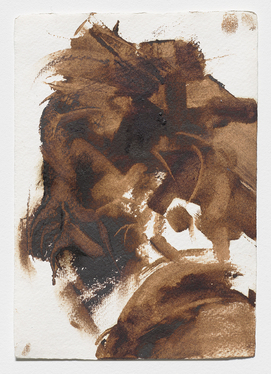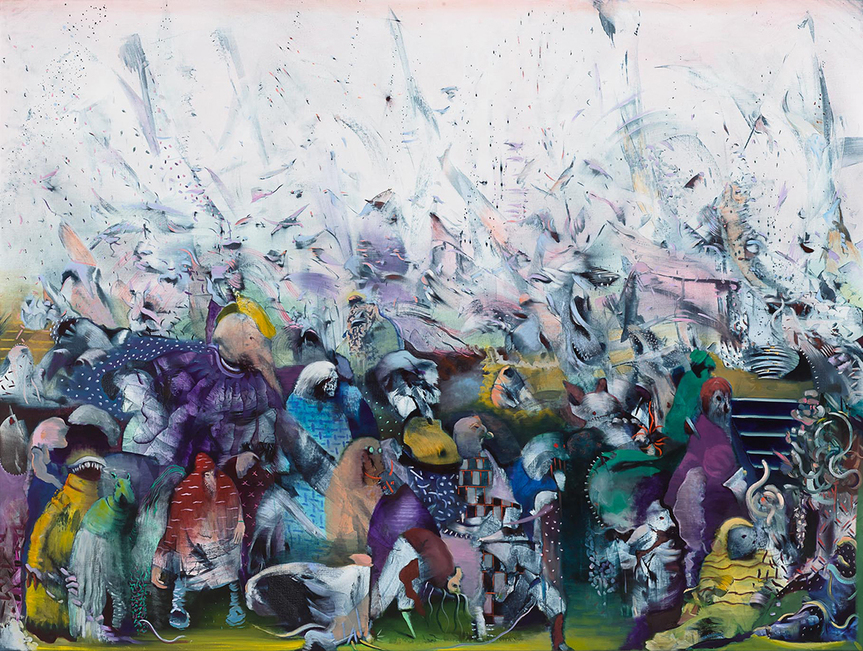-
From Current Issue
-
- Editor’s Letter Fire in the Heart
- Reviews I Gusti Ayu Kadek Murniasih
- Reviews 11th Seoul Mediacity Biennale: “One Escape at a Time”
- Dispatch Networked China
- One on One Monira Al Qadiri on Yukio Mishima
- Essays The rise of independent art spaces in pandemic-era Shanghai
- Features Tuan Andrew Nguyen
- Table of Contents
- Web Exclusives
- Archive
- Subscribe

R
E
V N
E
X
T
ALI BANISADR, Trust in the Future, 2017, oil on linen, 208 × 305 cm. Courtesy the artist and Sperone Westwater, New York.
The paintings in Iranian-American artist Ali Banisadr’s second solo exhibition, “Trust in the Future,” at New York’s Sperone Westwater gallery resemble dreamscapes. Building upon the abstract and figurative works presented in his 2014 show “Motherboard,” the artist’s latest, large-scale compositions appear to welcome allegorical interpretations. Whether his paintings are of nightmares or omens is unclear, reflecting the uncertainty of our troubled times.
Myth (2016) highlights icons such as pharaohs with headdresses and shamans donning medallions and pointed hats—figures who have assumed powerful roles throughout human history. Yet their authority has depended on widespread belief in certain myths, or what Banisadr refers to as an “imagined order” that has lent them power, which includes laws, religion and other forms of social cooperation. No single figure comes into focus; rather, the blurred faces encourage the viewer’s eyes to roam the canvas. With no clear focal point, the work deliberately resists precise definition.
For Banisadr, a synesthetic painter, the visual motion he renders on his canvas directly correlates to sound and vibration. Growing up in Iran during the Iran-Iraq War of the 1980s, the artist experienced air raids and bombings going off around him, whereupon he would run down to the basement and draw. Many years later, as a grad student in his thirties, Banisadr visited the D-Day landing beaches in Normandy, where he experienced a flashback: the artist remembered the crater where his school once stood, as well as the half-leveled buildings of his childhood. Soon after, he began making charcoal drawings based on the sound of explosions. Banisadr eventually moved on to experimenting with color and paint, but he said he continues to use sound as a “guiding force.”
With his imagination inextricably linked to concepts such as “energy” or “harmony”—terms he mentioned as essential to his process—an intangibility permeates his work. The seven ink drawings of the “Seven” series (2017) look like rough portraits or smudged photographs. Without clearly defined features, the faces lose all trace of personal identity, and the artist’s subjects are deprived of their humanity. Instead, we are left with generic bogeymen that are easy stand-ins for criminals, terrorists or enemies of the state. “From this imagined order, we fear them,” Banisadr said, alluding to how those in power exploit our lack of empathy or understanding.
The meaning behind the painting The Rise of the Blond (2016) was uncloaked once I recognized the yellow mane of a figure in purple looming above an anthropomorphized horde that shuffles to the right in an orderly fashion. Banisadr revealed that he painted the work during and in the immediate aftermath of last year’s US presidential election. His internalization of current events also inspired a tumultuous canvas, Mosaic People (2017), in which an obscured, faceless crowd clothed in brightly colored textiles scrambles in many directions. Smears of paint, like shrapnel, explode from the background, contributing to the overall feeling of chaos and confusion. Here, Banisadr paints people who are “being pushed out of their land.” Again, the viewer’s eyes must wander, our gaze trying to keep up with the setting’s intended movement.
A character that the artist calls a “cult leader,” identified by the mysterious symbol on his chest, is one of many spectral creatures in We Work in Shadows (2017). The painting’s earth tones suggest fire and heat, while actual yellow flames lick the body of a demon in the lower right-hand corner of the painting. The inhabitants of Banisadr’s underworld are hybrid monsters, simultaneously of our world and from another realm. Similarly, the figures in Trust in the Future (2017), the show’s namesake, appear partially human: up close, one can just make out a profile here, a hand there, before the kinetic scene swallows that body part again. Once we step back to take in the entire image, its monochromatic blue casts a fog over the setting, clouding our vision. A darker reading of the phrase “Trust in the Future” supposes the mantra may be nothing more than an empty promise about progress—yet another myth that is forced upon us.
Treasure (2016) places one of the artist’s personal memories in the context of an art historical moment: upon welcoming the birth of his now 17-month-old daughter, the artist likened the arrival of well-wishers at his home to the theatrical tableau of Hieronymus Bosch’s Adoration of the Magi (c. 1475), now housed in New York’s Metropolitan Museum of Art. “It was such a powerful thing to witness,” he remarked, observing how the infant possessed an energy or force, like gravity, that pulled in everyone around her. For Banisadr, the instinctual need to protect something so vulnerable offers a bit of optimism. The child embodies a future that her father can believe in—one that is even filled with hope.
Ali Banisadr’s “Trust in the Future” is on view at Sperone Westwater, New York, until June 24, 2017.







